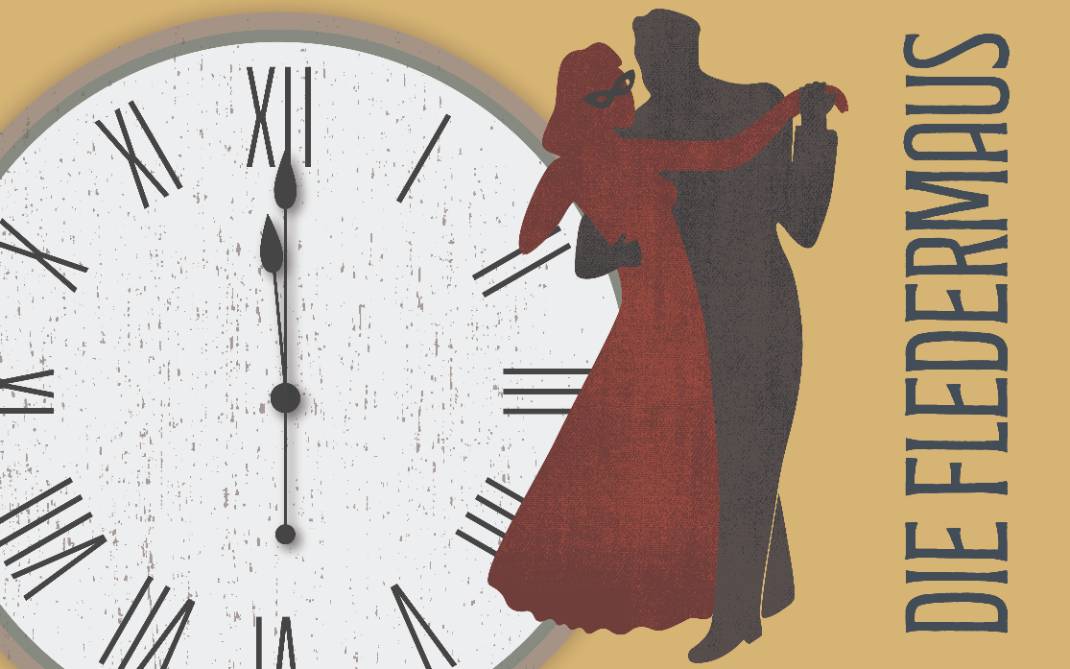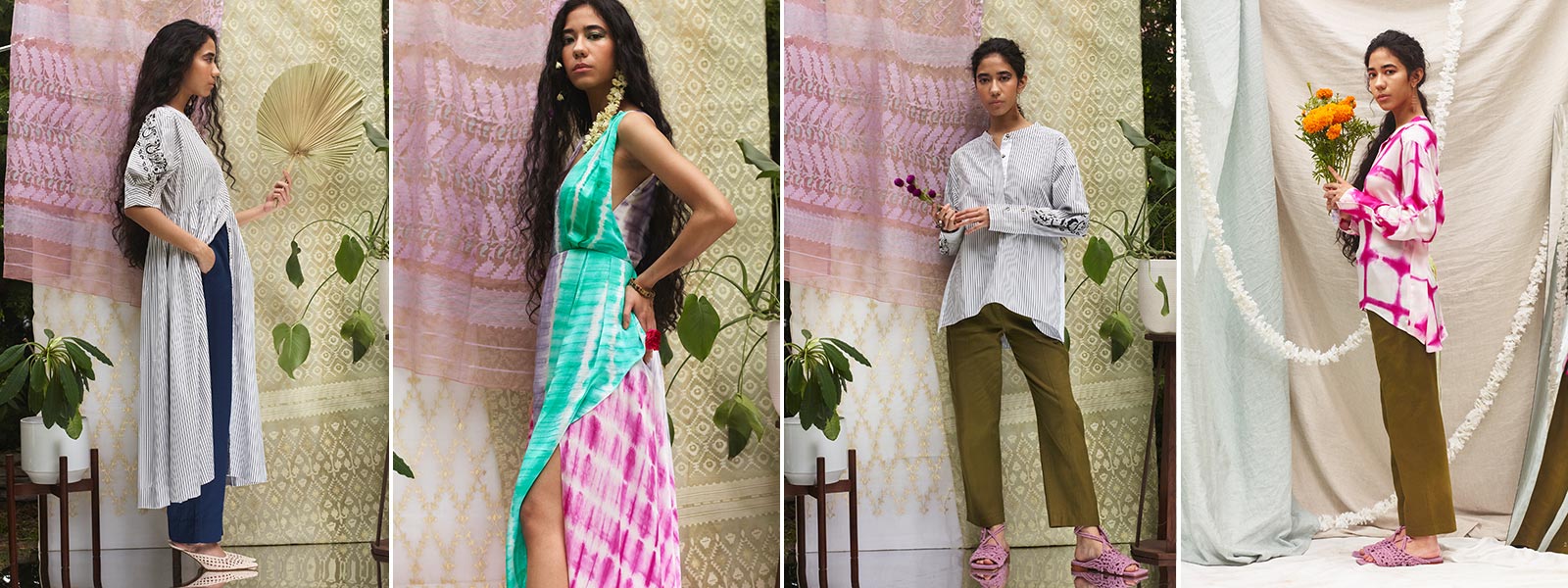Nyla Hasan
The views and opinions expressed by speakers and presenters in connection with Art Restart are their own, and not an endorsement by the Thomas S. Kenan Institute for the Arts and the UNC School of the Arts. This interview has been edited for length and clarity.
A graduate of the Fashion Institute of Technology with 15 years of experience working for some of the country’s top designers, Nyla Hasan in 2019 decided to create her own fashion line. A few complications — not the least of which was a pandemic — delayed the planned debut of the line, but in the fall of 2021 her dream became a reality when fashion brand the øther launched its first collection.
The øther quickly made waves for its graceful blending of South Asian and Western influences and its use of both inventive as well as traditional South Asian techniques and handiwork. The line was profiled in The New York Times and Vogue, and — given that the clothes are all made to order — Nyla is currently preparing a third production cycle since the launch to meet demand.
In this interview with Pier Carlo Talenti, Nyla describes how her own experience coming of age in two cultures informed the style and ethos of her line, making it truly distinctive, a candid reflection of its creator’s values.
Choose a question to begin exploring the interview:
- How did you decide to create your own line of clothing? And how long did it take you to come up with the name?
- Since you’re talking about fashion as storytelling and you’re talking about creating the øther to bridge these two cultures from which you come, I’m wondering if you can describe a piece in your collection that you think reflects the mission of the øther.
- I read an article in which you mentioned a term I’d never heard before: code-flexing, which I guess is a version of or is based on code-switching. What does it mean, and how does it manifest in your work?
- You went to FIT and worked for many years for some top designers. As you set out to create your own line, what lesson from your background best served you and what did you have to let go of entirely?
- You’re also really committed to supporting the work of artisans in Pakistan, correct?
- In a year and a half, while there was a pandemic, you had to gather up your workforce in South Asia. What was the biggest hurdle for you in that crucial year and a half?
- What are your dreams for the øther? How big do you want it to get?
- What do you think you’ve learned since the launch of the øther that might be a useful lesson for other up-and-coming fashion designers who are dreaming of launching something as singular as what you’ve done?
Pier Carlo Talenti: How did you decide to create your own line of clothing? And how long did it take you to come up with the name?
Nyla Hasan: I had been working in the industry for quite a while, and I had left my job, needed a bit of a reset and was at this point in my life where I was reevaluating what I wanted out of my life from every facet, from a creative standpoint, from a personal standpoint.
It came to this point where it was this pivotal moment for me in my personal life. I had a daughter a year and a half prior, and it really shifted my perspective on my responsibility as a human being on this earth and how I would leave it to my children. Also at the same point I was really reflecting upon my own identity and how I want to bring my children up in this world.
I live in New York City. It’s a very diverse environment, and it’s mostly why I’ve stayed. Also being in the fashion industry and it being in New York, there was so much that connected me to staying here. But at the same time, how I navigate the space as someone who’s mixed-race as well as how would I instill the cultural traditions that I grew up with or that I didn’t grow up with that I’m interested in taking on … all these things came to a head for me.
I’m not a designer who’s all about the ego and wants the fame and fortune. I just want to make some cool stuff, and I just want to put it out there in the world and share my work. So the name the øther was a reflection of how I saw myself as someone who’s lived and grown up in two polarizing cultures.
I lived in Lahore, Pakistan for about half of my childhood, and I also lived in and was born and raised in Connecticut, where my mother grew up, so I always had been toggling between these two polarizing cultures. I always felt like an other; I didn’t fit into either place. I always felt like I just was an outsider. Because I took on these two different cultures in different ways, I needed to assimilate or kind of blend in to fit in.
I think a lot of immigrants have that same kind of narrative, but mine felt a bit different because I was born here and I lived here until I was 10 years old. That’s a bit of a long backstory of how things shaped who I am as an adult and why I decided to go about doing something on my own. After designing for other people, I really was interested in making something on my own that I didn’t really feel existed — at least in American fashion — that represented a large majority of people here who have a narrative that hasn’t really been included in the American narrative.
To me, fashion is about storytelling; it’s my medium of art. The way that I want to express this narrative that has existed in America is by showing through fashion who these outsiders living on the periphery are who have been here for a very long time.
To me, fashion is about storytelling; it’s my medium of art. The way that I want to express this narrative that has existed in America is by showing through fashion who these outsiders living on the periphery are who have been here for a very long time. They’ve come to a point where second, third, fourth generations in, they’re still excluded from this narrative.
It was a very conceptual thing for a long time. I started thinking about it in 2019. It was just this idea, this idea of the øther. The øther came to me very quickly. It was kind of inspired by those government forms where you have to check a box of what race or ethnicity you are. I never felt represented in that. I was like, “Well, I’m more than one.” Sometimes it would just say, “Check one,” and I’m like, “Well, why is this so hard? Why is checking a box so difficult? I don’t fit into these boxes that society imposes on us as a collective.”
So that idea and concept then evolved into, “How do I translate that into fashion? I don’t want to make stuff for the sake of making stuff. There’s enough stuff in the world.” So I came at design in a way that’s responsible from the get-go versus how the fashion industry has been existing where everyone’s kind of backpedaling to, “OK, how can I make my process more sustainable?” I’m like, “Well, if I’m starting off from scratch, I might as well think about this as a larger picture.”
Pier Carlo: Since you’re talking about fashion as storytelling and you’re talking about creating the øther to bridge these two cultures from which you come, I’m wondering if you can describe a piece in your collection that you think reflects the mission of the øther.
Nyla: As I was designing the first collection, which I had started in 2020, I had a few pieces in mind of like, “This is what I want to put out there that reflects both cultures to me.” I felt like the narrative of this particular item had been co-opted. It is a kurta. It had been co-opted by a lot of “Western” or “global northern brands” that would exoticize it or make this very bohemian piece and call it a tunic.
I designed a kurta that actually reflected the design details of things that I think about, of clothing that my father wore when I lived in Pakistan. There are certain design details that are very nuanced that might not be noticed right away, but they’re very intentional. I did the kurta in a few different ways. The cotton version is in like a menswear stripe shirting, and everything is very intentional in terms of the juxtaposition between the masculine and feminine detail. I have hand-embroidered motifs that reflect a very South Asian kind of Islamic art reference, but there are squared arm holes and side slits, which is very traditional in a kurta.
Everything’s done in a way that’s slightly remixed. That’s the word I use because it’s not like a “modern update;” it’s how I interpret it. The Kurta Not a Tunic is what I named it, in the sense of reclaiming the origins of what that item actually is. It’s a little tongue-in-cheek because I feel like I see “tunic” used all the time and I’m like, “But it’s actually a kurta!” [She laughs.] And a kurta is a garment that’s not just from the South Asian diaspora; it’s widely worn around the world from a lot of global Southern nations and cultures, so it’s really celebrating that as well.
Pier Carlo: You mentioned your father wearing a kurta. Is a kurta traditionally a male article of clothing?
Nyla: It’s not gendered. Men and women both can wear it. That was also another thing where it’s gender-neutral in terms of the actual item, and it gives me a big range to explore that and how I can eventually incorporate more of that every-gender kind of mentality of designing for more than just women’s fashion. That’s also something I’ve been exploring and been interested in as well.
Pier Carlo: I read an article in which you mentioned a term I’d never heard before: code-flexing, which I guess is a version of or is based on code-switching. What does it mean, and how does it manifest in your work?
Nyla: Code-flexing is a term that I coined with a friend. She and I were talking about how we navigate the world as someone who is BIPOC. A lot of times we find ourselves code-switching. We’re conforming to the spaces that we enter, so we kind of read the room and kind of flip on or off certain aspects of ourselves to adjust and assimilate to the surroundings around us.
What if it’s this kind of pulsing, flexing, more organic form that exists within us, and as we’re moving through different spaces ... we flex the aspects that we want to showcase, that we want to be present?
I was just thinking more and more about it. I’m like, “But why do we have to do that? We should be who we are and all that we are in all the spaces we exist. Or flex between these different aspects of who we are on our terms, not based on who’s in the room.” We talked more about this idea: “Well, it’s not actually switching. Let’s not have that on-and-off switch there anymore. What if it’s this kind of pulsing, flexing, more organic form that exists within us, and as we’re moving through different spaces, like between personal and professional spaces and the different cultural spaces that we exist in — especially if we’re a part of different multicultural settings — we flex the aspects that we want to showcase, that we want to be present?”
Code-flexing became this term that we started using. I really started being interested in expressing how I design around it and how I personally navigate through these different places that I’m present in. It is really inherent in how I design. It’s hard to dissect, “OK, what is it and what is it not?” The kurta is a perfect example where, for me, I can flex between different cultural codes, wearing something like that. The way that I designed it, it can live in many different cultural codes and settings, and how I show up in those spaces really reflects that part of me. But it might be more subtle to some people.
I’ve been thinking a lot about how I style my clothing. Having lived in Pakistan and having to fit to the cultural codes there, there are certain things you can and cannot wear as a woman in that country. Adapting to those codes but on my own terms is something that I had to navigate a lot growing up, so going back to Pakistan as an adult, trying not to then, “OK, well here is my south Asian wardrobe that I’ve got to bring with me.” Instead, it’s like, “OK, well, what can I pull from my own wardrobe to bring there where I still can feel like myself but I’m not necessarily totally standing out like, ‘Oh, who’s that American over there, wearing a short skirt?’” [Laughing] Which is not OK over there.
It’s just this interesting, very nuanced thing.
Pier Carlo: You went to FIT and worked for many years for some top designers. As you set out to create your own line, what lesson from your background best served you and what did you have to let go of entirely?
Nyla: I think with fashion, brands and people who work for these brands get caught up in what everyone’s doing: “What is this person doing? What’s that person doing? What’s that company doing?” I learned, going into doing my own thing, I can’t. I can’t be interested in that because I don’t see anything else that exists like what I’m doing, so there’s nothing to model after. I’m kind of forging my own path in the dark, figuring it out.
It’s really, really hard as a creative person to not compare yourself to other people. I mean, I definitely do it. I think every person does it, especially with social media making it so easy to fall into that trap, but I had to constantly remind myself that what I’m working on isn’t like anything else that’s out there, especially within American fashion. There are a few brands who are doing things I really admire and they’re carving out a space for other POC designers. But for me, it’s just really navigating based on my gut and what feels right to me.
Pier Carlo: Which must be both liberating and terrifying in equal measures, I’m guessing.
Nyla: [She laughs.] Yes, absolutely, absolutely. Sometimes I don’t really know. Like I know in my gut this thing doesn’t feel right or like a certain decision that I have to make and then I get trapped in that “But what are other people doing?” And I’m like, “Wait, no! It doesn’t matter what other people are doing because they don’t care about the same things that I care about or they’re not putting their efforts towards the same things I’m putting my efforts towards, and so there’s no comparison.”
Pier Carlo: What about the way you operate your business? Is there anything you knew you knew you wanted to do differently?
Nyla: A lot of brands globally — this is not just in this country — overdevelop. That basically means that they design these gigantic collections, they order tons of fabric, and they don’t necessarily use all the fabric; they don’t necessarily sell all those products that they’re designing. What do they do with all this excess waste? There’s all this overconsumption of fabric and of resources before it even hits the market, before customers even see it. Some of it doesn’t make it to the light of day.
How I approach designing my collections is at a slower pace. It’s a tighter collection. It’s less 'stuff.' It’s more curated, and it’s every single piece I believe in.
Working for bigger brands, I learned that that burns out the people who are working on the actual product. It doesn’t necessarily lead to a better product because designing more doesn’t mean it’s better. So how I approach designing my collections is at a slower pace. It’s a tighter collection. It’s less “stuff.” It’s more curated, and it’s every single piece I believe in.
When I offer it up to the customer, I make what’s actually wanted, so everything is made to order instead of guessing. So instead of guessing, “Oh, well my projections of sales is X, Y, Z … .” Obviously I’m a new brand so I don’t even know what those projections are, but a lot of companies have these projected goals, and they produce X amount of pieces to hit the minimums that they have with factories.
What I do instead is I have preorders. Customers order what they like in their size, and at the end of the preorder cycle, I take those orders and I give them to the factory and will produce what’s actually ordered. That way I’m able to control my environmental footprint but also not order too much fabric and also maintain an easier workflow with the workers that I’m partnered with.
Caring more about the people and the product and how the product’s made is something that I’ve been really interested in. That’s not always considered in a lot of other companies, the actual people and their livelihoods.
Pier Carlo: Right, because you’re also really committed to supporting the work of artisans in Pakistan, correct?
Nyla: In the South Asian diaspora, yeah. I hope to be able to shine a light on each part of the diaspora, between India and Pakistan, Bangladesh and Sri Lanka and maybe even Nepal. Just what is the richness and cultures each country has, and what types of crafts come out of those regions? Because it really is so rich, and it’s almost like me reclaiming that narrative from that perspective of coming from that part of the world versus an outsider taking the narrative of the people there and expressing their appreciation. It’s a bit different to me.
I think I want to make sure I’m the most respectful towards those other regions of the diaspora and pay homage to them in the most respectful way.
Pier Carlo: So let’s see, the idea started in 2019.
Nyla: Yeah.
Pier Carlo: Your first orders went out in fall of last year?
Nyla: Yeah. [She chuckles.] It’s been a long journey.
Pier Carlo: Wow! So in that year and a half, while there was a pandemic, you had to gather up your workforce in South Asia. What was the biggest hurdle for you in that crucial year and a half?
Nyla: [She laughs.] Oh my God, I’m laughing because it was such a journey! I started in the fall of 2019. I was like, “OK, I’m going to launch in 2020. This is going to happen in early 2020.” I was like, “Oh, you know, I want to actually take a moment.” This is before the pandemic started. I wanted to take a pause, I wanted to really shift into manufacturing in South Asia. Before, I was making everything here and I had a slightly different spin on my idea, so the idea evolved, which is for the best. I made a trip to Pakistan in March 2020 in the hopes of finding a manufacturing partner there and developing product there.
Pier Carlo: This is just before the lockdown?
Nyla: This is March 1st, yeah. I was four months pregnant at the time. I traveled over there by myself, and I was like, “I’m going to make this happen. This is going to happen. I’m going to will this into the world. I don’t care. No one’s going to stop me, not a pandemic, not a pregnancy, not any other factory who flakes out on me. No.” So it was my pure will getting this into existence really that kept me going.
So I went to Pakistan, started working there, the pandemic hit, hit some difficulties there so had to shift, started working with a factory in India. They were a couple-years-old factory at that time, so they were looking for business. We found each other through mutual connections and past experiences. We started working together in late 2020. During that time of 2020, I had a baby, and then I was regrouping and trying to figure out, “OK, how do I shift and make this happen still?” I found this connection, and then things started rolling.
The beginning of 2021 is when things really started rolling. I was getting products developed over there and working with the artisans there on tie-dye techniques and embroidery techniques. On the styles, I did a lot of patternmaking here and was working with them super-closely. WhatsApp is our most used form of communication, where they’re sending me photos of the techniques that they’re doing or the patterns or the garments and we’re able to work through the design process.
I got the collection together and had it all in my hands by August. Developing a collection usually is a six-to-eight-month process. It was later than I wanted it to be. I wanted to launch earlier — but I was like, “You know what? I have it; I need to do it.”
The way that I went about launching it and how I formulated and offer my products is different than most companies. I had one “big collection.” It’s like 20 pieces; it’s not that big. I divided them up into drops, so then I’m able to offer new products over a span of eight months. It’s a very curated selection, so I’m not offering hundreds of products every month like most fast-fashion companies do. I’m instead offering five to eight products every few months, and customers are able to preorder what is current but also what I already showed. As a new brand, you’re in the state of discovery; people are discovering your brand.
What I had realized from past experiences is that customers will find you and then they’ll love what you did a few months ago but you don’t offer it anymore, so there’s no opportunity for them to be a part of that momentum for them and also for you. I had thought about that in a different way, like, “Well, I can still offer the products I offered in September now in March, and it’s OK because there are people discovering my work.”
Pier Carlo: Right, because it’s made to order.
Nyla: It’s made to order and they’re discovering my work months later. It’s not like everyone’s going to discover me on day one; it’s also going to take a few years. So I’m designing pieces that I can offer even in future collections maybe done in a slightly different way, but the base is there. I’m basically working on building that foundational product and design.
The hardest part about this first collection is I designed it so long ago. It’s having to sit with it for longer and having to appreciate it and being OK with and loving and appreciating my own work, wearing my work and having to talk about it for so long with people — like months and months, like a year and change later — and still having to maintain that same excitement for it. Whereas when I worked for other companies in design, I’d be designing six months ahead. Once I showed that collection, I’d be designing the next collection. I wouldn’t need to stop and sit and sell my product that I designed; I’d move on to the next. So it’s a little bit of a shift in pace!
Pier Carlo: What are your dreams for the øther? How big do you want it to get?
Nyla: I feel like I’m such a dreamer. I have so many ideas for the company, for the brand. I hate calling it a company. It is a company and I have to make money in order to do what I love to do, but I see it as this thing that’s much bigger than myself. I’m really interested in going into other spaces within the arts, collaborating with other artists on different projects that expand what the øther is and go deeper into it.
I’m really interested in film. I’m curious about NFTs. I’m just a curious person.
Pier Carlo: Oh, so you’re thinking the øther might be a bigger umbrella than just fashion?
Nyla: Yeah, for sure.
Pier Carlo: I see. Have you started any of the øther’s new projects or collaborations then?
Nyla: I’m in the beginnings of working on those things. I think I will update you as those things come up post this podcast.
I am really interested in the storytelling piece and bringing stories to life in a way that isn’t necessarily done within fashion. ... It’s not about what these people do; it’s how they got to be who they are, what’s their story.
I am really interested in the storytelling piece and bringing stories to life in a way that isn’t necessarily done within fashion. One small example of how I’ve been trying to do that within my means at this point in time is I’ve been profiling individuals from different backgrounds. I have this series called “Where Are You From?” It’s basically a photo essay. It’s an Instagram format right now, but I’m working on building more behind that. That’s the project that I am currently working on. I’m collaborating with someone on the writing piece and hopefully on the photography piece too and highlighting these individuals journeys.
It’s not about what these people do; it’s how they got to be who they are, what’s their story. When they’re asked where are they from, how do they unpack that? Because for some people, that question’s loaded. Like for me it is. I don’t have a simple answer for that question. I started digging more into it and talking with other people, and it’s not just others who have like a mixed-race background. It could be third-culture kids; transracial adoptees; second- and third-generation immigrants or first-generation immigrants; and so much more beyond that.
It’s been this really interesting process of meeting people and interviewing them. I’m so inspired by their stories because sometimes they really catch me by surprise in how rich and how authentic each story is and how it’s not represented in the larger American narrative. It’s not fueling my business in any way and I don’t care for it to. It’s more of, “This is my inspiration, and it fuels my creativity in a different way by connecting with people in a deeper level.”
Pier Carlo: It’s just different modes of storytelling. You did say that your fashion design was one type of storytelling.
Nyla: Exactly, yeah.
Pier Carlo: What do you think you’ve learned since the launch of the øther that might be a useful lesson for other up-and-coming fashion designers who are dreaming of launching something as singular as what you’ve done?
Nyla: Persistence. It’s the thing that I keep hearing. You’ve got to be persistent. You keep doing it, you keep doing it.
Pier Carlo: Where did you build that persistence? Where did that come up in your background? Was it always there?
Nyla: I don’t know. I mean, I am a super-driven, ambitious person. When I have an idea in my head that I’m really, really passionate about, that’s it. I am going for that. When I’ve spoken to other business owners and designers about their own ventures, that’s the thing I keep hearing: “You’ve just got to stick with it long enough.” It’s not going to be an overnight success; that’s not what I’m looking for. It’s just a slow build. It’s a slow burn. One day, things will click. That’s what I keep hearing. I’m like, “OK, I’m ready for that. When is that happening?”
That’s the thing that I keep hearing: It’s about the long game. It’s not about this flash in the pan like, “Oh, you’re a huge success.” And then what? Then you die out, you’re yesterday’s news, and that’s it. I don’t ever want to be that cool brand that is hyped up. I don’t care to be. I’m not that type of person either, in terms of being interested in the hype and buying into it. I keep reminding myself, “This is the long game. It’s a marathon; it’s not a sprint.”
That’s the thing for anyone going into business for themselves, if they’re not seeking venture capital or trying to make a quick buck, if it’s something they’re actually passionate about. That’s the one thing that I will pass on that I’ve heard from others that will keep me going. I’m thinking about 10 years down the line. “OK. I will be here. This business will be here, and I will just keep building it slowly brick by brick. I’m not going to force it to grow bigger than what it is until it’s ready.”
March 28, 2022






